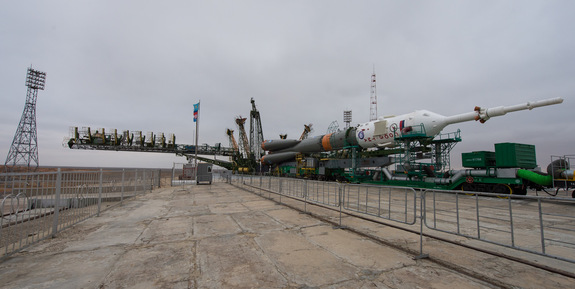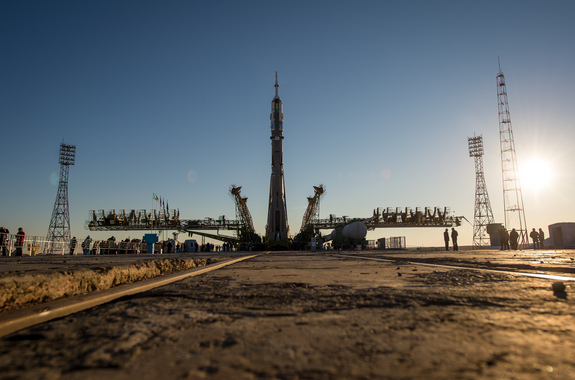A Russian Soyuz-FG rocket launches 5 satellites from Baikonur launch site on July 22, 2012, at 10:00 Moscow time.
Baikonur Cosmodrome in Kazakhstan has been the launch site for Soviet and Russian space missions since the beginning of space exploration in 1957. The first satellite and the first human flew into space from there. Today, the site is heavily used for Soyuz astronaut launches to the International Space Station.
The site has mostly been used to launch Soviet Union and Russian cosmonauts, but after the Cold War cooled, some American and European astronauts started to launch there as well. After the space shuttle program retired in 2011, however, NASA shifted to having all of its astronauts fly from Baikonur until the new Commercial Crew Program is ready to launch astronauts. Current estimates say this will happen around 2018.
Location and early history
To this day, Baikonur remains somewhat remote. It is 1,300 miles (2,100 kilometers) from Moscow. The launch complex is on a desert steppe east of the Aral Sea. The region is known for its harsh climate. While its average temperature is 55 degrees Fahrenheit (13 degrees Celsius), NASA says its temperatures can range from minus 40 F (minus 40 C) in winter to 113 F (45 C) in summer.
“The name Baikonur is misleading,” NASA wrote of the complex . “The former Soviet Union used the name and coordinates of a small mining town, Baikonur, to describe the location of its rocket complex. In fact, the launch complex is about 322 kilometers (200 miles) southwest of the mining town near Tyuratam in Kazakhstan. This misrepresentation was done intentionally to hide the actual location of the launch complex. Although the true location is now known, the launch complex is still referred to as Baikonur.”
Baikonur’s origins came with the Soviet desire to launch intercontinental ballistic missiles; the extended range and tracking system required did not fit existing Soviet facilities at the time. A site search was conducted in high secrecy and has only been revealed in recent decades to people such as Russian space historian Anatoly Zak, who pieced together the area’s early history through reading documents and doing interviews.
The reasons for choosing what is now known as Baikonur are complex, but one major factor (according to Zak) appears to be the existence of a rail spur connected with what was then called the Kazakhstanskaya Railroad. This allowed for building materials, and later the rockets themselves, to be transported to the site. Construction started in 1955 in high secrecy; by 1957, the United States was aware of an ICBM site in the area and had U-2 aircraft scanning the zone, Zak says.

A Soyuz rocket and spacecraft are seen at the launchpad at Baikonur Cosmodrome in Kazakhstan on March 16, 2016, ahead of a planned March 18 launch that will send three spaceflyers toward the International Space Station.
Credit: NASA/Aubrey Gemignani
Space-age pad
The first successful space launch from Baikonur is also the first space launch ever — the flight of Sputnik-1 , which left Earth on Oct. 4, 1957. The cosmodrome only officially received the name “Baikonur,” however, after cosmonaut Yuri Gagarin went into space on April 12, 1961 — also a world first. Rather than reveal the location of the facility, the Soviet Union achieved its world record by telling the International Aviation Federation that it had launched from the town of Baikonur , Zak says.
Prior to Gagarin’s flight, Baikonur was host to the worst launch pad failure in history, known informally as the Nedelin Catastrophe after a high-ranking Soviet official who was killed in the disaster. It happened when an R-16 missile detonated on the pad due to various factors (including skipped safety checks and a rushed launch schedule) and killed an estimated 150 people on Oct. 24, 1960. The incident was kept secret for decades, even from the families of disaster victims.
Baikonur was the site for all major Soviet launches, and remains so for Russian launches today. Some of its notable early missions include the first spacecraft to go close to the moon (Luna 1, 1959); the first flight of a female in space (Valentina Tereshkova , 1963); the first flight to carry two people (Voskhod 1, 1964) and the first crewed launch to a space station (Soyuz 11, 1971). Baikonur also was the launch site for two fatal missions; Soyuz 11’s three cosmonauts died during re-entry, and the parachute failed to deploy during the Soyuz 1 spacecraft re-entry in 1967, killing the single cosmonaut on board.
On July 3, 1969, the Soviets made a test attempt to launch a heavy rocket — capable of sending humans to the moon — known as the N-1. At the time, NASA was only three weeks away from making the first moon landing. A rocket failure caused part of the fuel to detonate, heavily damaging the launch pad and surrounding area. No fatalities were reported in the incident , Zak says, which was kept secret for some time. The N-1 program underwent four test launches between 1969 and 1972, all of which ended in failure.
The Soviets have launched missions to many space stations over the decades, starting with the fatal Soyuz 11 flight to Salyut 1 (the first space station) in 1967. Notably, the Soviet Union began opening its flights to other nations in 1978 under the Interkosmos program, which saw participating Soyuz astronauts from more than a dozen other nations through the late 1980s.

The Soyuz TMA-11M rocket is erected into position after being rolled out to the launch pad by train on Tuesday, Nov. 5, 2013, at the Baikonur Cosmodrome in Kazakhstan.
Credit: NASA/Bill Ingalls
Modern-day Baikonur
After the Soviet Union fell in 1991, NASA and Russia began joint missions to the Mir space station (including launching American astronauts from Baikonur) so that NASA could start learning from the Russians’ long-duration stays in space on their various space stations. Shuttle-Mir also was a precursor to learning to work together for the International Space Station program, which began construction in 1998. Some observers say the Shuttle-Mir program also allowed the U.S. government to financially stabilize the Russian space program during a difficult time, ensuring the two sides would stay allies. The first American to fly into space on a Soyuz was Norman Thagard, in 1995.
The United States retired its aging space shuttle program in 2011, by which time several Americans had flown into space on Soyuz. To fill the gap until commercial flights began, the United States paid for seats on the Soyuz for all astronauts going to the International Space Station for the U.S. segment. The Commercial Crew Program is expected to begin around 2018, which will greatly reduce U.S. demand for Soyuz seats.
While Baikonur used to be on Soviet soil, this changed with the breakup of the Soviet Union. After Kazakhstan declared independence, Russia began leasing Baikonur from Kazakhstan. As of 2013, the agreement extends until 2050 for an annual lease price of $115 million, plus $50 million in yearly maintenance for the facility.
But with NASA moving most of its astronauts to the Commercial Crew Program, space observer James Oberg told Space.com at the time that the Russians were starting to look at alternatives. That year, Russia began construction on a complex called Vostochny, which is in eastern Siberia near the Chinese border. The first launch took place in May 2016, and eventually the Russians plan to launch human space missions from that site. In 2016, construction on the site was estimated to cost 180 billion rubles, or $2.7 billion, according to Spaceflight Now .
Comments are closed.